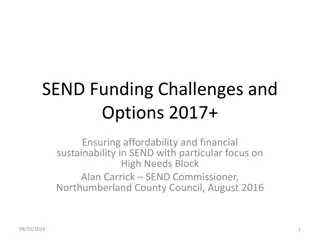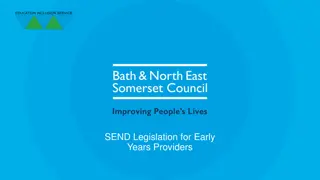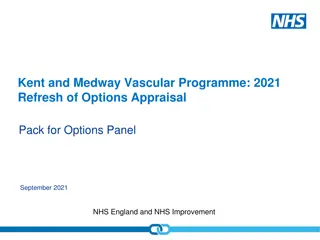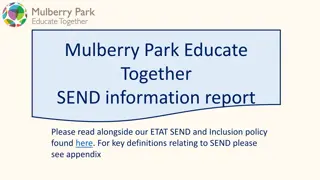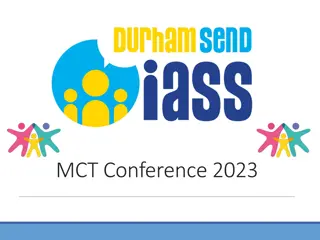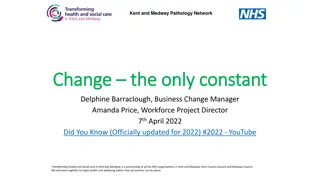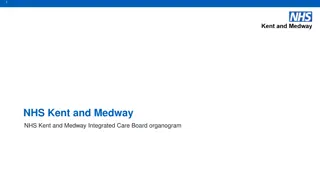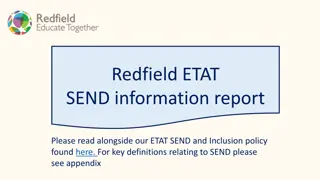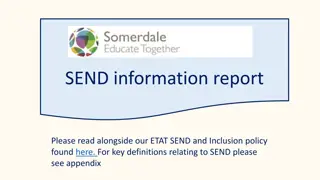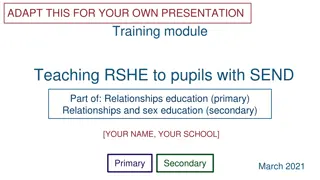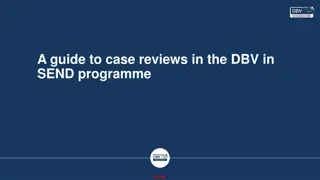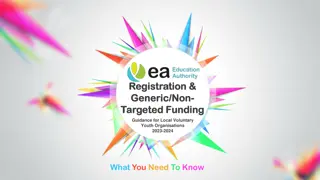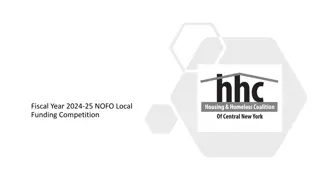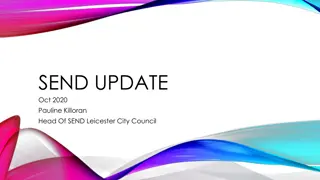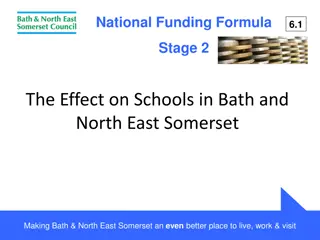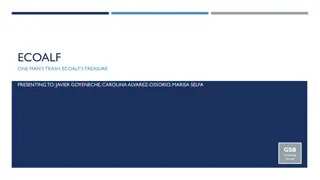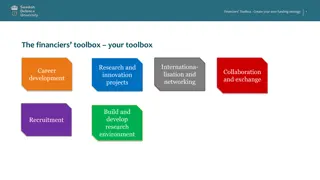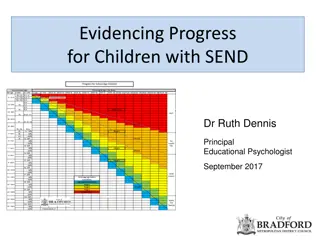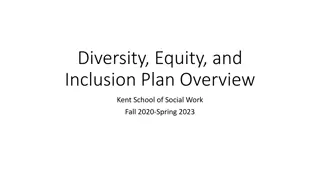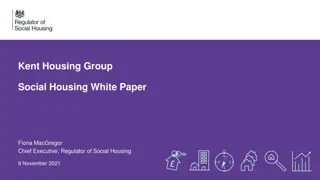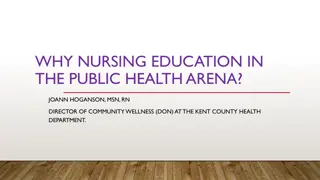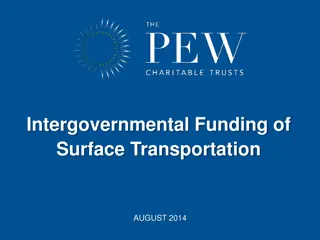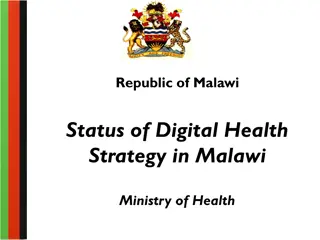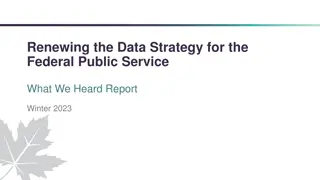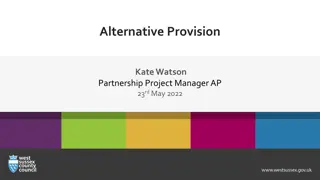Enhancing High Needs Funding and SEND Strategy in Kent
Kent's SEND Strategy aims to improve outcomes for children with special needs through capacity-building in schools, effective provision of support services, and better transitions between educational phases. The priorities for 2017-2019 include identifying children's needs early, enhancing workforce development, and ensuring inclusive education. By focusing on provision quality, capacity building, and preparing for adulthood, Kent aims to reduce SEND NEETs and improve overall outcomes for children with SEN.
Download Presentation

Please find below an Image/Link to download the presentation.
The content on the website is provided AS IS for your information and personal use only. It may not be sold, licensed, or shared on other websites without obtaining consent from the author. Download presentation by click this link. If you encounter any issues during the download, it is possible that the publisher has removed the file from their server.
E N D
Presentation Transcript
SEND Strategy Julie Ely Head of SEN
KENT SEND STRATEGY WORKING TOGETHER, IMPROVING OUTCOMES ACHIEVEMENTS: 2013-16 More children attending a better school Support for schools through LIFT and Early Years LIFT High needs funding without statutory assessment 500+ ASD, 300 SLCN and 300 SEMH Largest group Y1, then Yr2. Secondary schools make fewer applications but 63% non-Grammar and 47% Grammar schools applied. We are tracking Y6 into Secondary school More places in Special schools and in mainstream specialist resourced provision (SRP) Support and for families; IASK, Local Offer
KENT SEND STRATEGY WORKING TOGETHER, IMPROVING OUTCOMES Refreshed aims for 2017-2019 1. Improving outcomes; education, social, health and emotional well-being 2. Meeting statutory duties; Children and Families Act 2014 3. Creating greater capacity; address the gaps in provision; quality and range
KENT SEND STRATEGY WORKING TOGETHER, IMPROVING OUTCOMES Vision Good local schools; core standards, earlier intervention and inclusion Partnerships; school to school, workforce development, outreach support Provision and places Co-production, providers engaged with changes Good progress for every Kent child and young person with SEN
KENT SEND STRATEGY Priorities for 2017-2019 Identifying the right children at the right time Creating capacity in schools through workforce development particularly for pupils with autism Improving attendance and inclusion Better transitions between pre-school and school, moving to college Ensuring assessment is effective and meeting needs
KENT SEND STRATEGY Priorities for 2017-2019 Ensuring provision is improving outcomes Effective use of High Needs Funding Specialist provision where it is needed locally, reducing transport Preparation for adulthood; post 16 provision, high quality work experience, internships and support for apprenticeships Fewer SEND NEETs
KENT SEND STRATEGY Priorities for 2017-2019 Increasing parent satisfaction and confidence Children and young people with SEND and their parents are involved in decision making Creating more specialist places, particularly Secondary age Reduce parents frustrations with delay or accessibility Continue to promote awareness of the Local Offer Have a high quality statutory assessment process which delivers to timescales and engages parents at each step Have embed a culture of evaluating the impact of what we do to regularly monitor and review children s progress and parents experiences of schools and systems
WE WILL KNOW WE ARE ACHIEVING WHEN High needs funding has more impact on SEND progress and attainment Parents feel listened to and their views are acted upon and there is evidence of high levels of parental involvement in SEND assessment and review Young people are influencing decisions about them The local offer is informative, well known and used Parents are highly satisfied with SEND provision and have confidence in the support provided Fewer EHCPs needed in mainstream schools
Future years outlook The Government is proposing to introduce a National Funding Formula form 2018-19 In relation to High Needs, based on current proposals, we are unlikely to see any increases in High Needs funding that Kent receives for the next 4 years (2018-22) But we are still going to have growth in High Needs pupil numbers We have commenced a review of High Needs
High Needs Funding The numbers of pupils supported by high needs funding have increased In relation to High Needs costs in mainstream schools, there has been an increase of 14m since 2013-14 More than half of High Needs funded pupils do not have an EHCP But referrals for statutory assessment continue to increase
High Needs Pupil Numbers - By Institution 2013-14 2014-15 2015-16 2016-17 Latest forecast 2017-18 Latest forecast Actual Actual Actual Special Schools 3,272 3,349 3,572 3,688 3,733 Resource Provision 804 810 874 859 900 Mainstream Schools 802 860 1,475 1,916 2,129 Independent - pre 16 Independent - post 16 Independent 458 87 545 491 71 562 521 64 585 533 52 585 533 52 585 OLA Maintained 95 103 87 108 108 FE Colleges 467 570 636 845 845 SPI and CCP 55 141 TOTALS 5,985 6,254 7,229 8,001 8,299
Cost of High Needs ('000) - By Institution Type 1000 2013-14 '000 Actual 2014-15 '000 Actual 2015-16 '000 Actual 2016-17 '000 Forecast 2017-18 '000 Forecast Special Schools 67,048 68,543 68,118 70,326 71,093 Resource Provision 13,118 14,919 15,274 15,938 15,658 Mainstream Schools 8,755 8,899 14,398 20,808 22,344 Independent - pre 16 Independent - post 16 Independent 17,581 6,000 23,581 19,840 5,359 25,199 22,588 4,281 26,869 23,661 4,665 28,326 23,661 4,665 28,326 OLA Maintained 2,295 2,531 2,661 3,247 3,948 FE Colleges SPI and CCP 4,229 4,980 6,867 8,332 366 8,425 1,123 TOTALS Increase from previous year % increase from previous year 119,026 125,071 6,045 5.1% 134,186 9,115 7.3% 147,342 13,156 9.8% 150,916 3,575 2.4%
Balancing the 2017-18 High Needs Budget DfE increased the budget by 3.4m Schools Funding Forum agreed to the transfer of 5m from Schools budget to meet growth in mainstream High Needs Schools Funding Forum also supported some changes to the Notional SEN top up, which will save an estimated 1.8m
High Needs Funding in Mainstream Schools
DfE Guidance on High Needs Funding SEN Code of Practice 2015 section 6.99 states; Schools are not expected to meet the full cost of more expensive special educational provision from their core funding. The local authority should provide additional top-up funding where the cost of the special educational provision required to meet the needs of an individual pupil exceeds the nationally prescribed threshold .
TA Support An adult can be the facilitator of an intervention but are not an intervention or resource themselves. Class TAs supporting in any adult/child ratio, during a teacher led class based lesson, is differentiated teaching and would not be considered a SEN provision required to meet the needs of an individual pupil. Further guidance can be found in the Education Endowment Foundation Making the Best Use of Teaching Assistants https://educationendowmentfoundation.org.uk/resources/making-best-use-of- teaching-assistants/
Total number of HNF applications per district April 2016 to February 2017 Area With EHCP % with EHCP Without EHCP % without EHCP Total applications Tun Wells 58 36% 104 64% 162 Ton & Mall 105 46% 125 54% 230 Maidstone 107 44% 137 56% 244 Shepway 55 33% 114 67% 169 Ashford 74 35% 138 65% 212 Dover 81 36% 145 64% 226 Thanet 110 51% 105 49% 215 Canterbury 119 40% 182 60% 301 Swale 162 39% 257 61% 419 Dartford 83 43% 108 57% 191 Gravesham 74 40% 110 60% 184 Sevenoaks 75 44% 97 56% 172 County 1103 40% 1622 60% 2725
HNF Pupils and Secondary School Destination Year 6 HNF pupils and year 7 school destination in Sept 2016 Type of school Totals % Special school 80 49% Mainstream school 71 43% Other 12 8% Total 163 Number with HNF claims since Sept 2016 Mainstream pupils Number with EHCPs 43 (60%) 3 Number without EHCP 28 (40%) 2 Total 71 5
% of children with EHCPs in mainstream schools 60 50 40 30 20 10 0 yr R yr 1 yr 2 yr 3 yr 4 yr 5 yr 6 yr 7 yr 8 yr 9 yr 10 yr 11 Conclusion The % of CYP with EHCPs in mainstream schools drops by 20% from year 6 to year 7.
% of total HNF claims per yr gp with an EHCP 80 70 60 50 40 30 20 10 0 Yr R yr 1 yr 2 yr 3 yr 4 yr 5 yr 6 yr 7 yr 8 yr 9 yr 10 yr 11 % of HNF claims with an EHCP Conclusion Secondary schools HNF claims are more likely to be for an EHCP (58% 70%) than without an EHCP. Eg. Out of all the HNF claims for Year 10, 70% of the CYP have an EHCP and 30% don t.
% of CYP who received HNF and went on to be issued with an EHCP 111; 35% Issued with EHCP No EHCP 208; 65%
Review of High Needs Funding In partnership with schools we want to look at practice and provision where: There are more than 10 applications for high needs funding (will vary depending on size of school). Applications include a majority of 1:1 provision. Any HNF application that is over the special school cost for that need type. There is evidence of poor quality provision plans, poor outcomes or limited evidence of assess, plan, do, review cycle . Lack of evidence of impact and/or progress at reapplication. Limited use of the LIFT process and the available support to increase capacity in the school


